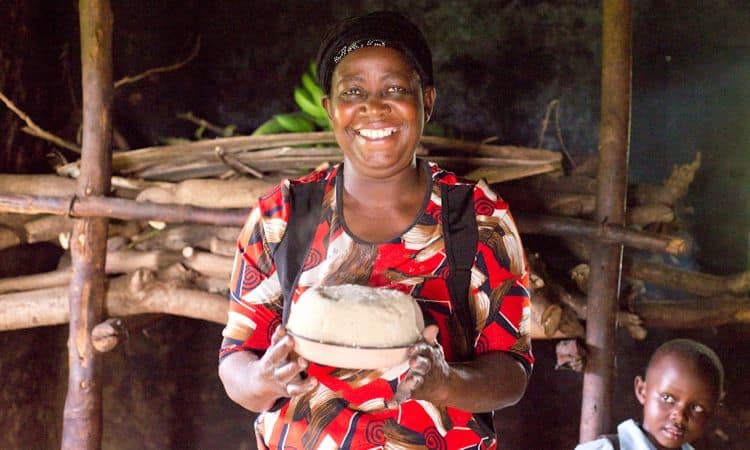“Ugali is my life and I can’t live without it. I’m addicted,” Agnes Makhanu laughs. “If I miss eating ugali in any single day, then I feel like I did not eat any food at all.”
It is hard to know exactly when ugali was first introduced in Kenya, but the fact remains—many families in Kenya share Agnes’ feelings about it. Ugali is a thick porridge made from boiling water and flour. The flour can be from maize, millet, sorghum, cassava, or a mixture of these.
A few years ago, ugali was predominantly the meal of communities living in the western region of Kenya, but now its popularity has grown rapidly, making it the staple food in many regions of Kenya. In particular, the Luhya community in western Kenya is well-known for being the best at preparing ugali.
In Sirare, western Kenya, the best activity in Agnes Makhanu’s busy day is cooking ugali for her family of eight.
“I love cooking ugali. Every time I cook, I get reminded of years back when I used to sit beside my mother as she taught me how to prepare ugali,” Agnes says.
Agnes heads to her kitchen located a few feet from her main house. It is time for lunch, and she is in a hurry to prepare food for her children who will soon arrive from school. She pushes open the door to reveal dark black walls, stained by smoke from many years of cooking. In one corner of the house lie three black stones arranged in a triangular shape. Eight feet above these stones is a large rack where Agnes stores her firewood.
Clearing away ash left between the stones, Agnes arranges firewood at her hearth and strikes a match. The small flickering flame on the tip of the matchstick transforms into a hot red and yellow blaze, and the hearth is lit.
Agnes sets her cooking pans on the fire. The size of the pan and the amount of water she pours in it depends on the number of people she is cooking for. On this day, Agnes expects only three of her children to come home from school. When preparing food for the whole family, Agnes measures two-and-a-half liters of water and uses a larger cooking pan.
For about ten minutes, Agnes waits patiently for the water to boil. In the meantime she adds more dry wood to the fire to keep it going. Once the water is simmering steadily, she reaches for a bucket of maize flour and scoops a handful from it. She shakes the flour from her hand. Fine grains spread on the surface of water until it is completely covered. Agnes says this makes the water reach a boil more quickly.
Sure enough, a few minutes later the water begins to boil and Agnes pours in three additional scoops of flour. When the water reaches heat again, she starts stirring it gently, adding flour and stirring to make a solid mixture.
Methodically working her hand back and forth, Agnes stirs the ugali in silence. Hands clasping tight on a large wooden spoon, she stirs away every lump in deep concentration. The only noise in the room is the crackling sound of the flames consuming the firewood.
Occasionally, Agnes pauses and lets the ugali rest for about 20 seconds, then flips it in the pot, cuts through it, and stirs it again. All this time, her feet hold the cooking stones steady.
Once more Agnes stops stirring and lets the ugali cook. This time, she lets the ugali rest for about two and a half minutes. A hissing noise from the ugali cuts through the silent kitchen. The room slowly fills with a sweet smell of baked ugali.
“This ugali is ready. I can tell it is ready when I start catching the smell of it baking,” Agnes says through a smile, the light of the flames dancing on her face.
Fetching a big round plate from a pile of dishes at the corner of her hut, Agnes sets the ugali on top of the sufuria and lifts the pot from the fire. Turning the pot upside-down, she reveals a big round mass of ugali.
The children arrive, and one-by-one, they gather around the kitchen table. After a brief prayer, the family happily begins scooping up small handfuls of ugali. The day is complete.

Curious to taste the East African staple? Here’s how to cook ugali at home (serves 1):
- Heat half a liter of water until the water boils.
- Add a handful of maize flour to the boiling water.
- After the water reaches a boil again, add more maize flour, stirring slowly.
- Pause the stirring for 10-20 seconds to allow the ugali to cook.
- Repeat stirring and pausing until a thick consistent mixture is formed.
- Let the ugali rest on fire for about three minutes—or until the smell of baking ugali fills the air.
- Turn the ugali onto a serving plate.
- Serve the ugali while hot. Ugali is commonly eaten with stews of vegetables, fish, beef, or chicken.







